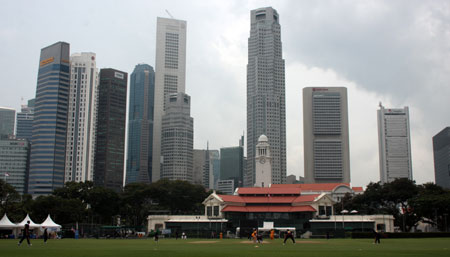I'm always left lamenting cricket's stature in Singapore after each sojourn to the densely populated Southeast Asian country.
This gnaws at me because cricket should not be in a parlous state of irrelevancy considering Singapore's rich history with the bat and ball game. The British introduced their quaint invention to the unsuspecting Singaporean populace in the 1830s, and cricket was considered to have traction with the mainstream entering the 20th century. An Australian team led by Bert Oldfield toured Singapore in 1927 during cricket's period of fruition.
 Walk around Singapore today and grandeur remnants remain. The Singapore Cricket Club (right), steeped in its British colonial opulence, is an historic and cultural treasure but these days more renowned for being a social setting for the elite than its cricketing roots. On a weekend stroll, one should not be surprised at the sight of red rock hurtling at willow on the plethora of cricket fields that consume Singapore's premium space.
Walk around Singapore today and grandeur remnants remain. The Singapore Cricket Club (right), steeped in its British colonial opulence, is an historic and cultural treasure but these days more renowned for being a social setting for the elite than its cricketing roots. On a weekend stroll, one should not be surprised at the sight of red rock hurtling at willow on the plethora of cricket fields that consume Singapore's premium space.
Indeed, the Singapore Cricket Association (SCA) has more than 100 teams in its league and there have even been several ODI events staged on the island, most memorably a tri-series in 1996, featuring Sri Lanka, Pakistan and India, made famous for Sanath Jayasuriya blazing the then fastest 50-over ton off 48 deliveries. But no international fixtures have been played on Singaporean turf in the past decade, as cricket continually fades into obscurity since independence from the British in 1963.
The British once lauded Singapore for its strategic location and in recent decades the country has emerged into a major hub for trade, communications and tourism. Singaporean culture has often been derided for being absorbed, even obsessed, with education and business excellence, resulting in the detriment of the arts. Recently, the Singaporean government has placed more emphasis on leisure, in a bid to attract tourists and ensure its citizens don't become disenchanted with drudgery.
Sport has been a beneficiary of this cultural change, highlighted by the Singapore Grand Prix motor race now an annual fixture on the Formula One World Championship calendar. The Singapore Sports Hub, with its centrepiece 55,000 seat stadium, is expected to be complete within 18 months, fuelling excitement amid Singapore's sporting society.
SCA vice president Mohanavelu Neethiananthan believes the Sports Hub, estimated to have cost about SG$1.3b, could propel a cricket renaissance in Singapore and help lure international competitions.
"We are keen to stage international tournaments in Singapore but we were always told that we need a stadium to hold 25,000 people," he says.
 "We would like to host ODI or t20 international matches at the new stadium. Some rugby matches in the 2019 world cup will be played there, so I think it is possible to attract international cricket. We believe we could fill the 55,000 capacity stadium if India came, especially since 300,000 Indians live in Singapore."
"We would like to host ODI or t20 international matches at the new stadium. Some rugby matches in the 2019 world cup will be played there, so I think it is possible to attract international cricket. We believe we could fill the 55,000 capacity stadium if India came, especially since 300,000 Indians live in Singapore."
Before its grand dreams materialise, the SCA is aware of the difficulties arousing mainstream curiosity with its national team, coached part-time by Trevor Chappell, mired in the ICC's World Cricket League's division four. Instead, its focus is to strengthen cricket amid the grassroots and rekindle a foothold back into the schools.
"We had 30 schools playing cricket, now there are only about 10," Neethiananthan laments.
"It is sad but we are not daunted and won't give up. Schools look at sports that are very popular and have big participation, so cricket has been restricted in the school sport curriculum. The government does support cricket, which reassures us that the sport has a bright future here."
Neethiananthan believes embracing the burgeoning t20 format could be fundamental to cricket's climb up the Singaporean sporting ladder.
"The Singaporean cricket community have been adverse to t20 cricket," he explains.
"This is because clubs pay a lot of money for its grounds and thus don't want shortened matches to be played."
Singapore has started to register in the international cricket psyche. The country's pizazz was showcased to cricket's elite during the ICC's annual conference in Singapore three years ago. In August, Singapore will host an eight-team Asian tournament, featuring India, Pakistan, Bangladesh and Sri Lanka, with the Test nations to field their emerging players.
"To run cricket costs us about SG$1.5m, and we've had financial assistance from the government, ICC, Asian Cricket Council and sponsors," Neethiananthan says. "We believe cricket has made enormous progress in the past two decades."
I'm reminded of Singapore's reputation for swift development during each visit, with new high-rises, landmarks and milieus dotting my vision. The government's propensity for development combined with an intrinsic work ethic within the masses ensures this growth.
Don't be surprised if cricket too enjoys a meteoric rise in Singapore.